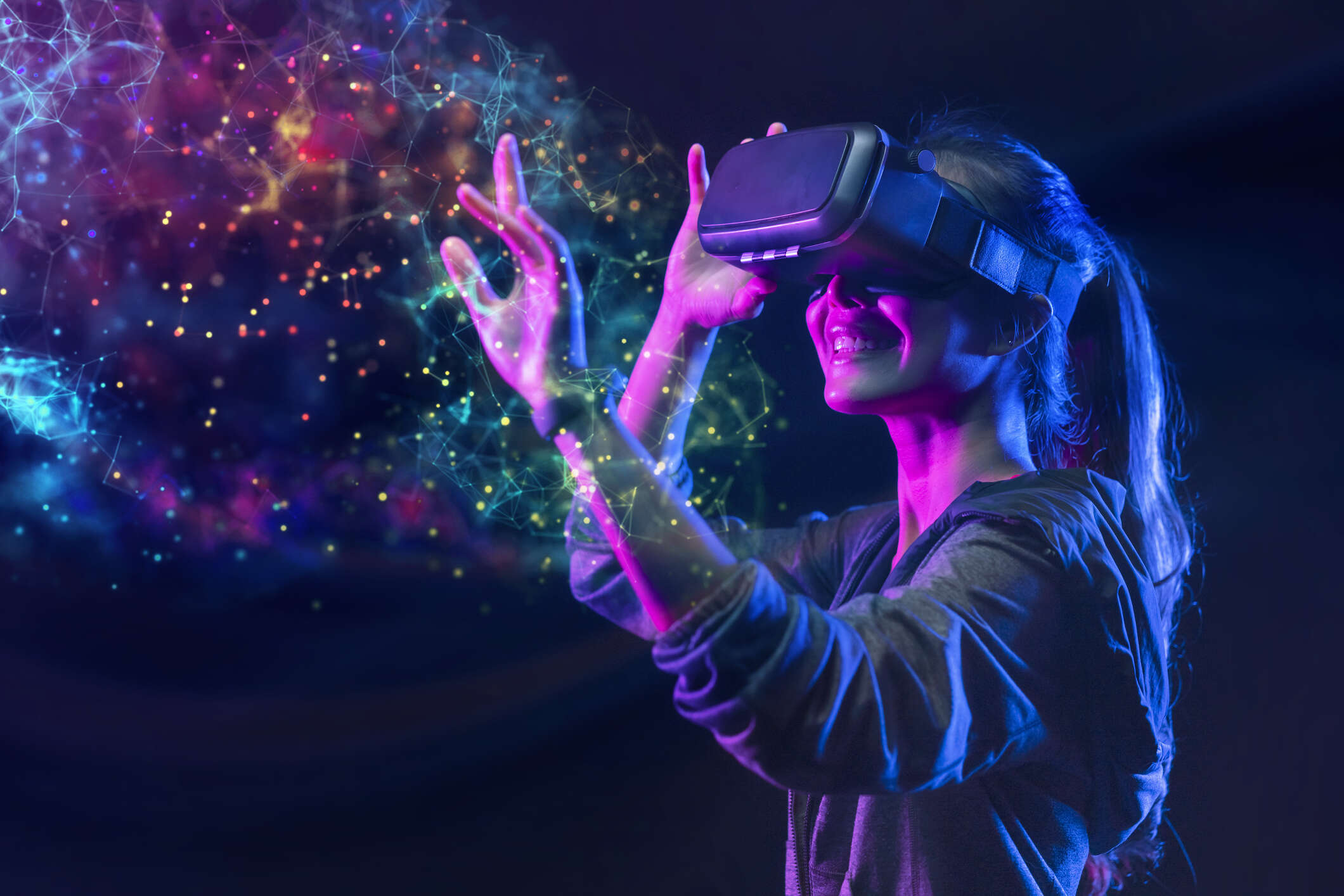METAVERSE INFRASTRUCTURE
SIMPLIFIED VERSION OF A METAVERSE ECOSYSTEM
• The space: a shared and open environment, with high bandwidth networks and exchange centers, which also allow social immersion.
• The interface: is the hardware that allows users to access the Metaverse and includes VR and AR headsets, mobile devices, PCs and game consoles, smart glasses, a headset accompanied by two controllers, gloves or contact lenses.
• The monetary infrastructure: refers to the payment that supports the system, crypto or non-crypto.
• Network type: centralized, decentralized or hybrid.

Infrastructure: low-quality decentralized or high-quality centralized?
The Metaverse to be realized will require numerous infrastructure and design choices.
Should it be open, built by open, permissionless protocols, or closed, built by Web2 platforms and easier to use?
The closed Metaverse , like that of Facebook, is outlined with a handful of corporations that own and control the servers, databases and hardware, this involves the loss of private data by users and their subsequent traceability. A centralized vision extracts painful economic returns from its creators and inhabitants, who are also victims of countless advertisements.
Although metaverses exist even without blockchain technology, such as Meta's Horizon Worlds, Venues, or Worksrooms, several large metaverse projects currently rely on blockchain, cryptocurrencies, and NFTs . An example of how cryptographic metaverses differ from centralized metaverses is the use of NFTs to give individuals control over their digital assets.
NFTs allow players to collect unique in-game items, such as skins, that can be transferred to other platforms. Cryptocurrencies , on the other hand, serve as a transaction currency in almost any virtual environment that integrates with cryptocurrency wallets .
But what is a decentralized Metaverse?
Cryptocurrency metaverses, in their current form, are open platforms where users can sign up to play games, earn cryptocurrencies, own their identity, purchase land and NFT based digital collectibles using native cryptocurrencies to vote on the evolution of the platform itself.
These ecosystems allow users to obtain real monetary value for their time on the platform.
The Open Metaverse today appears, sadly, as a conceptually utopian version, granting absolute property rights, sovereign identity and a community-governed, freely interoperable network.
Ensuring "privacy by design", the Open Metaverse is a participatory medium built by thousands of creators, designers, developers and companies.
It needs to be a fair economy to allow both creators and participants to profit, and not just enrich a few companies behind the platforms!
Essential elements of a Metaverse

To reach a true Metaverse, open or closed, 7 essential ingredients are required.
DECENTRALIZATION
Decentralization is the ruling principle of a proper Metaverse. With “decentralization” we mean an ecosystem not owned or operated by a single entity (or a few powerbrokers ), but rather a more transparent environment that helps solve ownership/control issues in the Web2.
In this vision, the internet will be able to return to its original project of an entity free from the tech giants who dominated it for the past two decades. However, likely Big Techs will continue to have a large role in accessing the Metaverse as they have one key system controller: apps.
Indeed, the original promise was an open internet, but in reality everyone lives in several “closed” areas created by BigTech, which are the only ones with access to the algorithms of what is seen and clicked on.
Centralized platforms tend to be friendly but only to attract new users. They abuse user rights and platforming, with captive economies and aggressive levy rates; unlike decentralised systems, which have equal ownership of rights and reduced censorship.
PROPERTY RIGHTS
People who are currently buying in-game items, like “skin” or “emote” aren't actually buying them — they're renting them ! One challenge we are facing today in the online world is that we own nothing. If the game decides unilaterally to change the rules or close forever, players will lose all access. People have become so accustomed to renting the centralised services of Web2 that the idea of actually owning something seems strange. Yet, most of us give away our data for free every time we use the Internet, and that same data is then sold back to us in the form of advertising.
The digital world should follow the same logic as the physical world: when you buy something, you own it. It's your property.
Just as courts enforce these rights in the physical world, so too should the code enforce them online.
Isn't it amazing that true digital property rights were not achievable before the advent of blockchain technology?
SOVEREIGN IDENTITY
Identity is related to property rights: you can't own anything if you don't own yourself. As in the real world, people's identities must be able to exist throughout the Metaverse without having to rely entirely on centralized identity providers.
But identity is also linked to authentication. Internet does not have a built-in user authentication system. This has resulted in numerous login solutions, managed individually by different applications. In the Web2 Meta, Google, or Apple solve this problem but use social login or Single Sign-on ( SSO ) to collect data, track people's behavior and build businesses that serve more relevant ads. The service is free, but, as often happens online, it is actually "paid" with user data.
Therefore, innovating the authentication process is impossible as it depends exclusively on the honesty of the companies behind the platform (which act as guardians of our data).
Web3 cryptography enables authentication without relying on intermediaries, allowing people to control their identity, either directly or through services they choose voluntarily.
Wallets, such as Metamask, enable people to verify themselves; Sign-in with Ethereum, launched in 2021, and the Ethereum Name Service ( ENS ) contribute independently to the concept of digital identity, enabling its evolution.
COMPOSABILITY
It is the ability to mix and match software components such as lego bricks ; it is the principle of systems design. Any developer can build better software using code someone has already developed.
Composability is closely related to interoperability, as in the Metaverse resources can be traded and used both on and off the native platform (within games like Minecraft and Roblox, you build digital assets but you can't move them to outside of that context or change its internal functioning).
If users can't interact with the digital assets they carry from one platform to another, then this can't be a metaverse!
OPEN SOURCE
True modularity is impossible in the absence of openness, i.e. the practice of making code available, redistributable and editable at will.
Developers and creators (not platforms), need full control to be completely innovative. If codes, algorithms, markets and protocols are transparent, manufacturers will be able to pursue their ambitions by building sophisticated and secure experiences (openness leads to safer software as it makes concepts more knowable and eliminates any information asymmetries).
COMMUNITY PROPERTY
Community ownership prevents unilateral control of the system.
In a Metaverse, all stakeholders have a voice in proportion to their involvement in the governance of the system. Community ownership via tokens allows participants to be aligned with the network. Participants in DAOs are moving away from the formal rigidity of corporate structures towards more flexible and democratic governance experiments.
More simply, it is a community driven by its users.
Blockchain-based games use NFTs to tokenize gaming activities, ensuring users complete ownership of their purchases. These games may also incorporate 'play to earn' (P2E) mechanics, whereby players monetise time spent in the game in exchange for digital goods. In some cases, users can also lend their NFTs and monetise their use by others.
These platforms create an ecosystem in which users benefit from the time and resources invested in the platforms; not only do they have full control over their online purchases and identity, but they can also contribute to the development of the gaming platform through a governance vote.
SOCIAL IMMERSION
The pandemic has underlined the need for more immersive experiences.
Metaverses enable people to make a living, do business, and gain status. Realism allows people to immerse themselves in the virtual world emotionally.
• If a virtual world is missing any of the above parts, it cannot count as a fully formed Metaverse.
• Openness and decentralization are the pillars on which the entire building rests.